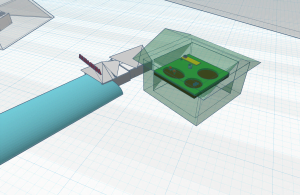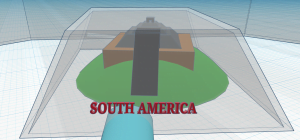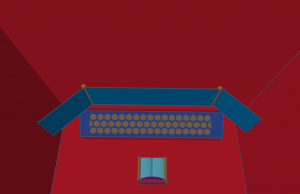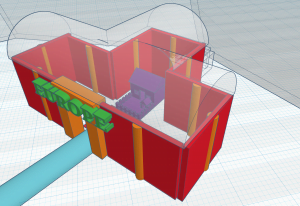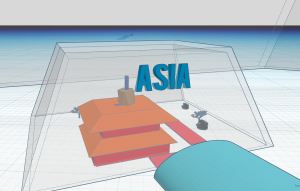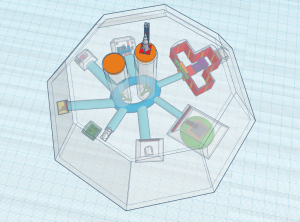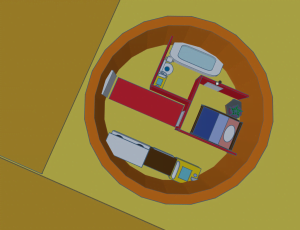Moon Camp Explorers Gallery 2019-2020
In Moon Camp Explorers each team’s mission is to 3D design a complete Moon Camp using Tinkercad. They also have to explain how they will use local resources, protect astronauts from the dangerous of space and describe the living and working facilities.
Team: SMOTERA
Robokids South Surrey Surrey Canada
External link for 3d
|
Project description
Our Moon Camp is made by the United Space Administration and has seven barriers. In six of these barriers is a different continent, each containing their respective unique architecture and culture. In the first barrier is Asia, with pagodas as buildings. The North American barrier has 3 levels, each representing a different country: USA, Canada, and Mexico. The South American barrier contains a pyramid on a hill, with small houses surrounding it. The European barrier has houses similar to Amsterdam’s canal houses. The African barrier is a group of many African huts, arranged in a village-like area with brown trees in front. The Australian barrier has a greenhouse, where the plants are grown, and the main residences are shaped like the Sydney Opera House. The last barrier contains a facility which produces essentials for the other barriers, such as water, oxygen, etc. |
|||
|
Where do you want to build your Moon Camp?
Close to the Lunar Poles Why did you choose this location?
We will likely build our moon camp close to the Lunar Poles, where the location is not directly on the Lunar Poles. Since the Lunar Poles contain lunar ice which is very useful, it also has nearly no sun. This means that fuel for our robots will have to be imported. However, importing fuel is also very costly, as you need to prepare ships to transport fuel to the moon. We will likely do it in a crater as well, as that provides much protection from asteroids as well as having a location to dig for valuable materials. |
|||
|
Water
|
Food
|
Electricity
|
Air
|
|
We will be able to gather water by melting lunar ice from inside the poles, which will be acquired from mining at the poles. We will be able to identify water sources by testing for hydrogen at the craters. This water will then be transported to the water tanks, which they will filter and store for later usage. |
We can farm food from greenhouses, which will most likely be fast growing plants that yield many calories, such as corn and potatoes. We will water these plants with the hydrogen dioxide from the tanks, and also provide them artificial sunlight from the solar panels. The scientists on the moon base will also help create lab grown and vegan meat, which will supply a portion of the protein to the astronaut’s diet. |
The most abundant power source will be solar power, as there is little atmosphere on the moon, which allows for much of the sun’s energy to permeate through the panels. During the lunar nights, we will create energy by using both hydrogen and oxygen extracted from the lunar ice to generate energy via rocket fuel. We will also use nuclear energy as an alternative during the night, and also burn biomass to recycle waste. |
There are multiple ways of getting oxygen. One way to do it is to extract oxygen from the lunar ice, creating breathable air. We can also recycle air breathed by humans through electrochemistry. We send an electric current through a CO2 molecule, causing an oxygen atom to break off, creating breathable air. We can also give the CO2 to plants, which cycle around and emit oxygen from photosynthesis. |
|
How do you plan to build your Moon Camp? Which materials would you use?
We plan to build the moon camp from both imported materials and resources readily found on the moon’s surface, such as regolith, a good construction material. However, we will most likely import the materials similar to glass and mirrors. Because of the heavy workload and relatively slow efficiency, we will use robots to build the base, instead of manpower. We will put charging stations near imported materials, so the programmed robots will have power to build each barrier. They will likely work during the lunar nights, charging during the days when there is sunlight, and operating during the nighttime. |
|||
|
The Moon environment is very dangerous for the astronauts. Explain how your Moon Camp will protect them.
We will build our base inside a crater, near the crater walls. These will provide natural shielding for the robots during building. The base has strong walls to protect against meteors and rocks. We will also have thermal insulators to protect us from the heat and cold. In order to protect the barriers, we will use radiation shielding. |
|||
|
Describe a day on the Moon for one of your Moon Camp astronauts
When our astronaut, Jeff wakes up, he looks out the window. Jeff lives in the Asian barrier, and he has a job as a lunar ice and minerals miner. After Jeff eats his breakfast and brushes his teeth, he heads to the garage to take his ship. Here on the moon, people use ships as transportation to and from work. He drives his ship to his mining area, where he will work until midday. After his shift ends, he has a quick lunch, and decides to visit his friends in every barrier. First he arrives at the North American barrier, and walks into a white house styled building. Jeff takes the elevator to meet David. The elevator here is quite peculiar. In order to go up, a fan pushes you. Because there is low gravity, the fan is all that is needed. When Jeff arrives at Gerald’s room, they talk for a while, and then Jeff leaves. Jeff then goes to the Australian barrier, to meet his friend Melvin. Melvin lives at the very back of the Australian barrier, next to the greenhouse. Next Jeff goes to visit his friend Jafari at the African barrier, they talk for a while, and then Jeff goes to the European barrier to find his friend Xander. He goes to the back of the large barrier, and talks with Xander. Next Jeff goes to the South American barrier to talk with his friend Fernanda. After they talk, Jeff goes home, and goes to sleep. |
|||


